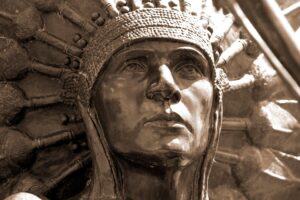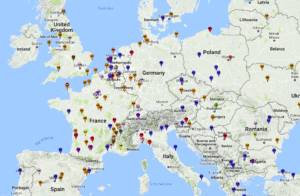The gunman accused of murdering 10 people in a Buffalo supermarket seemed to fit a familiar pattern. Isolated and bored during the pandemic, he had become increasingly radicalized by consuming white-supremacist content online. He had previously threatened a shooting at his high school and been sent for a mental health evaluation, according to authorities. After he carried out the violent solo massacre, in which he targeted Black shoppers, local police said they believed he had acted alone. So it’s no surprise that Payton Gendron, 18, was widely portrayed as a “lone wolf” attacker, like many white-supremacist terrorists before him.
But the gunman did not act in a vacuum. He saw himself as part of an engaged, active community. In the lengthy online manifesto being examined by authorities, he situated his alleged crimes as part of a larger movement. Part of the document is written in a conversational question-and-answer format. It includes sections with titles like “what do you encourage us to do?” and exhaustively cites his “many influences from others” about how to take violent action to prevent white Americans from being “replaced” by Jews, immigrants, and people of color. Dozens of pages lay out a clear instruction manual for the next attacker to follow.
“I think that live streaming this attack gives me some motivation in the way that I know that some people will be cheering for me,” the alleged gunman’s manifesto states. After driving several hours to a grocery store chosen for the high percentage of Black residents in his area, he donned a military-style helmet with a GoPro camera attached, which he used to broadcast the massacre for several minutes.
To analysts of racially-motivated extremism, the Buffalo shooting highlights one of the most pernicious and poorly understood aspects of the recent wave of domestic terrorist attacks. Even when crimes like these are committed by solitary extremists, the perpetrators see themselves as acting on behalf of a movement. “There is a community of like-minded individuals that give these people strength and make them feel like they’re part of a greater cause,” says Daryl Johnson, a former Department of Homeland Security senior analyst who authored a 2009 report warning of the rise of right-wing and white supremacist extremism. “And when you have that sense of community, it makes your cause seem more legit.”
Read More: The Lives Lost in a Buffalo Supermarket.
For a new generation of extremists, this online engagement with white-supremacist movements has taken the place of formal affiliations, group meetings and plots, former officials and experts say. But it should be taken just as seriously. Manifestos circulate from attacker to attacker, who build on and claim allegiance to one another while laying out the playbook for the next violent act.
The Buffalo shooter’s manifesto is covered in anti-Semitic and racist memes and disinformation, making it tempting to characterize it as the delusional ravings of a madman. But such documents, however abhorrent, need to be understood as part of a coherent political ideology, former U.S. extremism officials and experts tell TIME—one whose reach extends far beyond fringe Internet forums. About 1 in 3 U.S. adults believes an effort is underway to replace white Americans with immigrants for electoral gains, according to a new poll, which is the root of the “replacement theory” cited by the Buffalo attacker.
That’s why portraying individuals like the Buffalo shooter as lone extremists whose self-radicalization on the Internet led them to commit inexplicable, “evil” acts divorces their actions from the larger movement they belong to. “We shouldn’t be dismissing these people as mentally ill or just a one-off,” Johnson tells TIME. “There are many, many people out there that are on a spectrum of radicalization following each other’s path.”
Rarely has this feedback loop been laid out as clearly as in the case of the Buffalo shooter. The alleged gunman did not leave a hint of doubt as to his motivations, chronicling his own radicalization in his manifesto. After “extreme boredom” during the early months of the pandemic, he wrote, his browsing on outdoor-sports and gun forums led him to white-supremacist material. But it wasn’t until he saw a video of the 2019 Christchurch, New Zealand mosque shootings that he was inspired to action, he said.
Read More: Inside the Biden Administration’s Uphill Battle Against Right-Wing Extremism.
Significant sections of the Buffalo gunman’s document are copied from the manifesto of the New Zealand man who killed 51 people in the massacre he live-streamed in Christchurch. The Buffalo shooter also casts himself as a hero in the mold of other racist mass shooters, including Dylann Roof, who killed nine Black parishioners during a Bible study in Charleston, S.C., in 2015. He situates his act as part of “the movement,” discusses using “techniques that increase media coverage,” and encourages fellow extremists to “use edgy humor and memes in the vanguard stage, and to attract a young audience.”
“This is not just violence in the name of what they believe to be a righteous cause. It’s also performance, it’s signaling…to potentially like-minded people,” says Seyward Darby, a journalist and researcher of the evolution of white-nationalist movements. “The proof is in the text: this has been signaled before, and someone has literally read it, adopted it and done it again.”
“There’s no such thing as a lone wolf,” Darby adds. “Racism and white supremacy, they are not mental illnesses, they are learned behavior. Saying that is a way for people in positions of privilege and power to comfort themselves that they have no responsibility here.”




